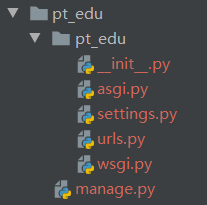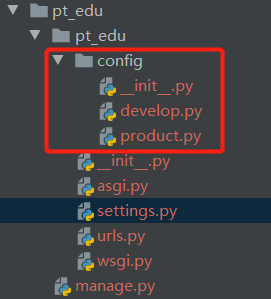Reset Configuration
1. Execute the following code to create a django project pt_edu:
django-admin startproject pt_edu

2. Create a package config folder, create two files in the config py package folder, respectively develop.py and product.py:

3. The following code was added manage.py, asgi.py, wsgi.py replaced:
# Os.environ.setdefault ( 'the DJANGO_SETTINGS_MODULE', 'pt_edu.settings') # by the environment variable PROJECT_PROFILE to develop or product, so that different loading configurations django Profile = os.environ.get ( ' PROJECT_PROFILE ' , ' develop ' ) os.environ.setdefault('DJANGO_SETTINGS_MODULE', 'pt_edu.config.%s' % profile)
manage.py as follows:
#!/usr/bin/env python """Django's command-line utility for administrative tasks.""" import os import sys DEF main (): # os.environ.setdefault ( 'the DJANGO_SETTINGS_MODULE', 'pt_edu.settings') # by the environment variable PROJECT_PROFILE to develop or product, so that different loading configurations django Profile = os.environ.get ( ' PROJECT_PROFILE ' , ' Develop ' ) os.environ.setdefault('DJANGO_SETTINGS_MODULE', 'pt_edu.config.%s' % profile) try: from django.core.management import execute_from_command_line except ImportError as exc: raise ImportError( "Couldn't import Django. Are you sure it's installed and " "available on your PYTHONPATH environment variable? Did you " "forget to activate a virtual environment?" ) from exc execute_from_command_line(sys.argv) if __name__ == '__main__': main()
asgi.py as follows:
""" ASGI config for pt_edu project. It exposes the ASGI callable as a module-level variable named ``application``. For more information on this file, see https://docs.djangoproject.com/en/3.0/howto/deployment/asgi/ """ import the from django.core.asgi import get_asgi_application # Os.environ.setdefault ( 'the DJANGO_SETTINGS_MODULE', 'pt_edu.settings') # by the environment variable PROJECT_PROFILE to develop or product, so that different loading configurations django Profile = os.environ.get ( ' PROJECT_PROFILE ' , ' develop ' ) os.environ.setdefault('DJANGO_SETTINGS_MODULE', 'pt_edu.config.%s' % profile) application = get_asgi_application()
wsgi.py as follows:
""" WSGI config for pt_edu project. It exposes the WSGI callable as a module-level variable named ``application``. For more information on this file, see https://docs.djangoproject.com/en/3.0/howto/deployment/wsgi/ """ import the from django.core.wsgi import get_wsgi_application # Os.environ.setdefault ( 'the DJANGO_SETTINGS_MODULE', 'pt_edu.settings') # by the environment variable PROJECT_PROFILE to develop or product, so that different loading configurations django Profile = os.environ.get ( ' PROJECT_PROFILE ' , ' develop ' ) os.environ.setdefault('DJANGO_SETTINGS_MODULE', 'pt_edu.config.%s' % profile) application = get_wsgi_application()
4. Load develop test environment default configuration, the production environment need to set environment variables start:
[Set Environment Variables] windows: set PROJECT_PROFILE=product PowerShell: $env:PROJECT_PROFILE="product" linux: export PROJECT_PROFILE=product
5.develop.py reference to the following configuration:
from ..settings import * DEBUG = True DATABASES = { 'default': { 'ENGINE': 'django.db.backends.mysql', 'NAME': 'django_db', 'USER': 'root', 'PASSWORD': '123456', 'HOST': '127.0.0.1', 'PORT': '3306', } }
6.product.py reference to the following configuration (the file can not be added to the inside git):
Develop.py with it.